Pushpanjali – A Floral Tribute!
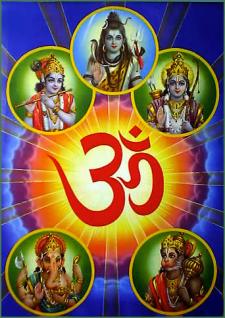
Pushpanjali –
The Offering Of Floral Garlands to
Deities in Ritualistic Worship – Part 1
Hindus offer Flowers to to Gods/esses in the temple as part of a Ritualistic Worship. This is called ‘Pu-ja’ – Pu stands for ‘Pushpam’ or Flowers and Ja stands for Japa or chanting the Holy names of Gods/esseses. Ja also stands for ‘Jalam’ or Water as water is sipped during the Worship while chanting the Holy Names of Gods/esses. ( This is called Aachamanam)
What do Flowers represent in Hindu Worship? Flowers represent ‘Nature’ or Prakriti. The word Prakriti is made of three syllables – Pra , Kri, and Ti. In Devi Bhagavatam, Sri Narada describes Prakriti thus. “The prefix “Pra” in the word Prakiti means Exalted, Superior, Excellent; and the suffix “Kriti” denotes creation. So, the Goddess, Devi, Who is the most excellent in the work of creation is known as the Devî Prakriti.
“Pra” signifies the Sattva Guna, the most exalted quality, “Kri” denotes the Rajo Guna and “Ti” denotes the Tamo Guna. The Sattva Guna is considered as the Highest as it is perfectly clear and free from any impurities whatsoever; the Rajo Guna is considered intermediate as it has this defect – it spreads a veil over the reality of things, so as not to allow men to understand the True Reality, while the Tamo Guna is considered worst as it completely hides the Real Knowledge. Thus when we offer Flowers to the Deities , we are actually praying to Gods/esses to to eradicate our Tamo and Rajo gunas and bless us with Sattwa guna which is conducive to the “Flowering of Consciousness.”
Offering Flowers to Deities is an important part of Hindu Worship. Different Gods/esses love different Flowers. Traditionally, it is said that we should only offer those Flowers that have a pleasant Fragrance and are cultivated on good soil . Wild Flowers that spring up everywhere and those with thorns should be avoided. When we offer Flowers to Gods/esses, we are transmitting our Devotional ‘Bhava‘ or Emotion and are literally requesting God/esses to grant us Health, Wealth and Happines(both Material and Spiritual benefits.) Hence the expression ‘Yad Bhava , Tad Bhavet. ‘ It is the bhava of ‘Surrender’ and Faith. ( Sharanagati and Shradda)
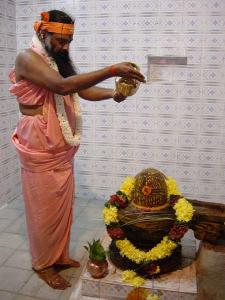
While doing the Abisekham , the Devotees will chant continuously the Lingashtakam –
Brahma Murari Sura architha Lingam,
Nirmala bashitha Shobitha Lingam,
Janmaja dukha vinasaka lingam.
That pranamami sada shiva lingam.
I bow before that Lingam, which is the eternal Shiva,
Which is worshipped by Brahma, Vishnu and other Devas,
Which is pure and resplendent,
And which destroys sorrows of birth.
To listen to the entire Lingashtakam , go to
http://www.youtube.com/watch?v=9MB1XQl0l3A&feature=related&pos=0
Shankar Baba is equally pleased if Bilva Leaves are offered to Him. It is believed that Sri Lakshmi resides in Bilva Leaves and by offering Bilva Leaves we are asking the Lord to bless us with Wealth and Prosperity. Bilva Leaves also have a cooling effect on the hot tempered Deity Shiva also known as ‘Rudra’ (the Wrathful One)
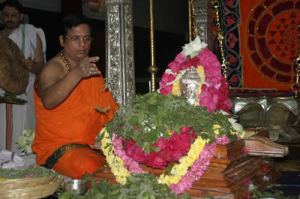
Bilva Puja to Lord Shiva
While offering Bilva leaves to The Shiva linga ,
it is customary to chant the ‘Bilvashtakam’ comprising of eight stanzas.
Here is the First verse .
tridaLaM triguNAkAraM trinetraM cha triyAyushhamh .
trijanmapApasaMhAraM ekabilvaM shivArpaNamh .
I offer one leaf of Bilwa to Lord Shiva,
Which has three leaves,
Which causes three qualities,
Which are like the three eyes of Shiva,
Which is like the triad of weapons,
And which destroys sins of three births.
To listen to Bilvashtakam, go to
http://www.youtube.com/watch?v=kCNSY19DK4Q
Lord Shiva is pleased with all kinds of worship – both internal and external worship. Internal worship is called Manasa puja . Adi Shankara Bhagvadapada sings thus in his Shiva manasa puja :
AtmA tvaM girijA matiH sahacharAH prANAH sharIraM gR^ihaM
pUjA te viShayopabhogarachanA nidrA samAdhisthitiH |
sa~nchAraH padayoH pradakshiNavidhiH stotrANi sarvA giro
yadyatkarma karomi tattadakhilaM shambho tavArAdhanam.h ||
Sambhu, You are my Self, my intellect is Goddess Parvati, your attendants are my vital airs, my body is Your temple, all enjoyments of sense-objects are Your worship, my sleep is samadhi, all my movements on my feet are circumambulations of You, whatever I speak is praise of You, and thus whatever action I perform is Your worship. Note: When a devotee totally surrenders to God, then whatever he does is according to God’s will. He gives up all sense of being a doer and an enjoyer. ( This Translation is by Shri Shastriji, chief moderator of ‘Advaitin’ list.)
To listen to Shiva Manasa puja , go to
http://www.youtube.com/watch?v=wCvVjlPAkl8&feature=related&pos=0
Here is a picture of Adi Shankara Bhagvadapada , The Author Of Nirguna Manasa Puja
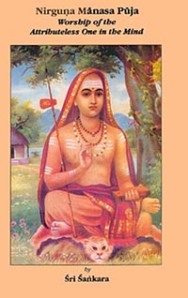
This is the first of the Series on how to worship different Hindu Gods/esses . Lady Joyce ( aka Radhe ) is the true source of inspiration behind this humble attempt. Bhakti Yoga is the firm foundation on which both Karma and Jnana yoga rests . Without Devotion or Love, Jnana is incomplete and without Atma ma Jnanam, Bhakti is not ripe. Karma yoga is the thread that runs through both Bhakti and Jnana yoga .
Shri Krshna himself says in srimad Bhagvad Gita
yoginam api sarvesam
mad-gatenantar-atmana
sraddhavan bhajate yo mam
sa me yuktatamo matah ( 6:47)
And of all yogis, the one with great faith who always abides in Me,
thinks of Me within himself, and renders transcendental loving service to Me—
he is the most intimately united with Me in yoga and is the highest of all. That is My opinion.
OM Namaha Shivaya
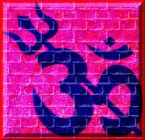
.
pathram pushpam phalam thoyam
yo me bhakthya prayacchathi
tadh aham bhakthy-upahrtham
asnami prayatathmanah.BG=9/26.
oh Lord Radha Krishna samarpayami.
sb
LikeLike
Re: pushpanjaliSaturday, June 13, 2009 4:26 AM
From: subrahmanian_v@yahoo.com
It is indeed a very nice post. The pictures, the shlokas/meanings and the audio links enhance the appeal of the article greatly. At the end you have said:
//Here is a picture of Adi Shankara Bhagvadapada , The Author Of Nirguna Manasa Puja//
But above this you have given Shiva manasa puja shloka Actually the Nirguna ….stotram is totally vedantic. If possible do a post on that.
I will certainly send the link to the present article to my friends.
Regards,
subbu
—
LikeLike
Hi,
Thanks for your post. in your post there is a line “Here is a Picture of a priest bathing the Shivalinga with the Pancamrit liquid !” and below that there is a picture with swamiji and Lingam. He is Pontiff of Avadhoota Datta Peetham, Mysore. He is a great Swamiji and very well recognized by Kanchi Matt and many more saints. He is not a priest. I know you did without knowing about him. Please change the title of that picture or change the picture with a priest.
Thank You!
LikeLike